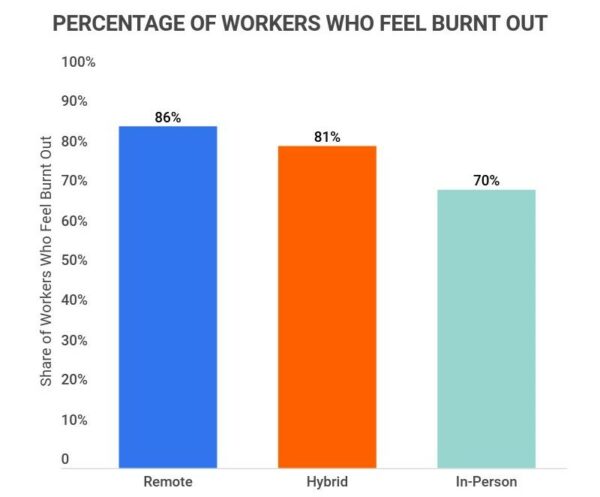Working remotely can be good for you, but depending on your character, you can also experience remote work burnout. Remote work has created opportunities, especially after the pandemic, allowing many workers to avoid long commutes, have more flexibility, and spend quality time with their families. However, there seem to be some side effects to it as you might be experiencing some work burnout just like your onsight counterpart. Apart from burnout, remote workers are experiencing loneliness which comes from not having enough face-to-face communication.
However, remote work burnout or any work burnout is the new normal. To get your remote teams back on track, we’ve put together this article on how to navigate and beat remote work burnout. By the end of this article, you should be able to strike a better work-life balance and go back to enjoying the countless benefits of remote work.
What is Remote Work Burnout?

Remote work burnout is a state of emotional or mental exhaustion experienced by remote workers due to prolonged stressful professional experiences which leave them emotionally and mentally drained. The concept “Burnout” originated in the ’70s when a study carried out by a psychologist saw employees begin to lose motivation and get depressed after working too hard. Since then the word has been used to describe physical and mental exhaustion, a lack of engagement, and worsened performance in the workplace. It has often led to a lack of productivity and performance and employees not being able to meet demands at their workplace.
Statistics to Explain Remote Work Burnout
According to a research summary analyzed by Zippia

- 86% of employees who work from home full-time experience burnout.
- 67% of remote workers report feeling pressured to be available all the time.
- Only 30% of remote workers completely avoid working on the weekends.
- 51% of remote workers feel they don’t have support from their employer to deal with burnout issues.
- 45% of employees working remotely due to the pandemic report working more hours than before.
- Furthermore, in a July 2020 survey of 1500 respondents by FlexJobs and Mental Health America (MHA), 75% of people have experienced burnout at work, with 40% saying they’ve experienced burnout during the pandemic. While 37% are currently working longer hours than usual since the pandemic started.
- Studies show that the work-from-home movement has had a significant impact on the mental health of remote workers. Nearly 70% of those workers say the COVID-19 pandemic represented the most stressful period of their professional lifetime, outweighing a number of historical events. This is at least partly due to tensions building pre-pandemic.
- Over 69% of employees are experiencing burnout symptoms while working from home, while more than 50% of employees in Europe have experienced burnout situations in 2021.
- In the US, 77% of American employees have battled burnout in their current jobs.
- According to a Microsoft survey, 41% of the global workforce is planning to tender their resignations because of high stress at the workplace.
Why Do People Experience Burnout When Working Remotely?
Since remote work can be done anywhere in the world, employees have to balance their work and home lives in the same space. Due to the flexibility that comes with remote working, workers can easily lose track of time and overwork themselves. Here are good examples of why remote workers experience burnout.
- Unplugging from work during non-work hours.
- Working overtime out of fear of getting laid off
- Feeling isolated from co-workers and any available support
- Lack of face-to-face communication
- Blurring work-life balance, especially with extra stresses such as kids at home.
- A lack of structure or control when making the remote transition.
- Working in a chaotic working environment
- Working too much and not mentally disengaging from work.
- Feeling your work isn’t visible or recognized.
- You are taking on too many responsibilities.
How To Notice Remote Work Burnout
It can be difficult to notice burnout, especially when you are on a distributed team. But here are some signs you should look out for if you are working remotely. You might be suffering from remote work burnout if you experience the following
- When you are unable to complete tasks on time.
- A sudden drop in engagement, like an employee not participating in video conferencing calls or taking much longer to return emails than they used to.
- A decrease in the quality of an employee’s work.
- Showing symptoms of mental and physical ailments such as rising stress, trouble sleeping, and headaches.
- A change in attitude, such as an employee who has lost their enthusiasm or a formerly positive worker who is suddenly outspokenly negative.
- An uptick in sick days.
- Losing track of tasks and time because of too much work.
- Experiencing a lot of emotions like anger, sadness, and irritability.
- Not getting proper sleep or experiencing insomnia.
- Drinking more alcohol than normal to cope with burnout.
- Physical symptoms such as headaches, illness, or dizziness.
- Experiencing depression.

How To Navigate The Remote Work Burnout
1. Set Clear Boundaries
To avoid being burned out, you need to set boundaries and keep your professional and personal time separate. This way, you can have enough time to work and at the same time spend quality time with your family. To achieve this you can set daily working hours, schedule regular breaks and avoid working too long without a break. When you go on break be conscious about how you are using your breaks. Don’t work when on break. You can take a stroll, talk to other family members or take a snack. Turn off electronic alerts or remove distractions to help focus on the most important work or projects for a set period. Have a plan of what you want to achieve for the week.
2. Create Stability and Structure
Another way to navigate through a stressful remote work routine is by creating stability. As a remote worker, you can create a system that is being used in most onsight offices. This way, you can have more stability and a structure in place that will guide your activities so you don’t overstress yourself. One way to do this is by
- Having a closing time will help you know when to pack everything up for the day. take a break
- Have a plan for what is to be achieved each day and even every week.
- Make use of time management tools to set clear time limits for tasks. This way you don’t spend every damn minute on every task. You can choose to tackle the easiest ones to the most complicated ones.
- Set project milestones
3. Communicate and connect
Communication is an important part of any job. The ability to communicate well and effectively in a working environment goes a long way in boosting the morale of employees. This is one of the problems faced by remote workers. They often feel disconnected from other employees which could lead to loneliness and boredom. We are social beings that need interaction and most remote workers struggle to feel connected to their virtual peers. One way to do this is by suggesting either a video conference call every week or an activity that will bring all the employees together.
4. Include yourself in company activities
As a remote worker, you can include yourself in company events. You can let this known to your boss and explain the benefits it will bring to you mentally and emotionally. loneliness and boredom can reduce life expectancy by a staggering 70%. Remote workers might lack the sense of community and daily interaction that is experienced by in-office teammates. However, there are different ways to stay connected and engaged with your team even if you work remotely.
You can organize meetings, host monthly trivia nights, and conduct interactive webinars with your team and the rest of your colleagues. You can also create a digital water cooler or discussion board where employees can socialize and connect with each other. You can even check in with your boss if the company can go on a retreat where people can get to know each other.
The idea here is to get you to interact more with your team members and employees. This way remote workers don’t feel left out.
5. Take vacations
Another way to avoid burnout while working from home is to take vacations. Working from home might not be as stressful as working onsight, but stressful nonetheless. Take a one-week or 2-week break. Go somewhere, do things you love. Maybe go to a nearby destination, stay in an Airbnb, cook for yourself, go cycling, or do anything you like.
6. Eat Healthy Foods
You can avoid burnout by eating healthy food. When working you burn a lot of calories and you need to eat good food to replenish the lost energy. Eating nutritious foods will give you more energy and replenish your strength. As there are many good things about working from home, it also comes with its own set of problems like unhealthy food choices. Keep yourself healthy by eating the right foods to prevent burnout at work. Eating nutritious meals will help you work for longer hours without feeling tired and drained.
8. Get Enough Sleep
Lack of rest and sleep is another cause of remote work burnout. Remote workers often work all day long and even work at night to meet deadlines. Research shows that people need around eight hours of sleep each day to function correctly. If you are not getting enough sleep, you will find it challenging to focus on your work and remember crucial tasks. Furthermore, getting enough sleep can help you have an excellent day and feel more productive. Lack of sleep and working overtime is never a good sign which can lead to remote work burnout.
How Can Employers Help Remote Workers Navigate Through The Burnout
There are different ways employers can help their employees navigate remote work burnout. It includes
1. Providing support
Employers need to know that those who are working remotely might feel left out. However, they can remedy this by supporting them and making them feel like others. Organizing face-to-face meetings and updating them on the happening around the company. Providing the tools they need to succeed while working from home is another way you can prevent burnout.
2. Organize events
As an employer, you can organize events to bring your employees together. You can host webinars or a trivial night or an online game where your team can participate. Organizing live streaming fitness classes, and virtual parties, hosting monthly trivia nights, and conducting interactive webinars including virtual and in-person options as often as possible create a more inclusive culture and encourages connections that could last beyond that in the workplace environment.
3. Create a mentorship program
Another way to prevent remote work is to assign mentors that will be checking on each remote worker from time to time. This will help create a sense of belonging and inclusiveness for remote workers. The mentor can help with work problems and provide any support to help remote workers ease their stress.
4. Encourage vacations and retreats.
Retreats and vacations are good opportunities for your employees to take a break from work and relax. You can include this in your company’s culture. Give your remote and even onsight employees a break from time to time. Also, you can go on retreats once a year. This will help employees(both remote and onsight get to know each other). Not only will this help them mentally and emotionally, but it will also strengthen their bond.
Conclusion
The idea of people working from home is here to stay and it is not going away anytime soon. Since technology keeps advancing. Work burnout among remote workers will unfortunately increase if not managed well. Working from home can be beneficial, but to enjoy it, you have to work smart and not risk burnout. The above tips can help you prevent remote work burnout and have more time to enjoy the perks of having a remote job.







